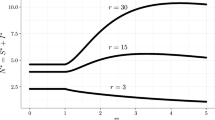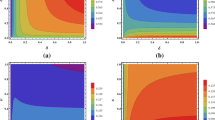Abstract
The paper analyses the management of an infectious disease in a sympatric metapopulation, under both Nash and cooperative behaviour, through the development of a differential game and an optimal control problem with connected local state variables. As pathogens are renewable resources with negative value, the problem may be non-convex. Since the disease can be transmitted across various connected populations, externalities may be involved. A numerical application is presented, with reference to a livestock disease that can be transmitted between herds on common pastures. The results suggest that optimal eradication in finite time should be pursued when possible. However, optimal eradication is not always feasible (sometimes eradication can be only achieved asymptotically), and the ecology of the disease is of paramount importance in this respect. Also, convergence to an internal steady-state does not minimise the present value of the disease damage and control cost (a result consistent with the existing literature). Ignoring these results may lead to inadequate policy design.
Similar content being viewed by others
References
Anderson RM, May RM (1991) Infectious diseases of humans: dynamics and control. Oxford University Press, Oxford
Anishchenko VS, Astakhov V, Neiman A, Vadivasova T, Schimansky-Geier L (2007) Nonlinear dynamics of stochastic and chaotic systems. Tutorial and modern developments. Springer, Berlin
Auld MC (2003) Choices, beliefs and infectious disease dynamics. J Health Econ 22: 361–377
Bailey NTJ (1975) The mathematical theory of infectious diseases and its applications. Griffin, London
Barrett S (2003) Global disease eradication. J Eur Econ Assoc 1: 591–600
Barrett S, Hoel M (2007) Optimal disease eradication. Environ Dev Econ 12: 627–652
Barro RJ, Sala-i-Martin X (2003) Economic growth. The MIT Press, Cambridge
Basai Feresu S (1990) Leptospirosis in cattle in Zimbabwe. Ambio 19(8): 394–396
Basar T, Losder GJ (1999) Dynamic noncooperative game theory. SIAM, Philadelphia
Behnecke H (2000) Optimal control of deterministic epidemics. Optim Control Appl Method 21: 269–285
Bennett R (2003) The ‘direct costs’ of livestock disease: the development of a system of models for the analysis of 30 endemic livestock diseases in Great Britain. J Agric Econ 54(1): 55–71
Bennett R, Christiansen K, Clifton-Hadley R (1999) Preliminary estimates of the direct costs associated with the endemic diseases of livestock in Great Britain. Prev Vet Med 39:155–171
Bharti AR et al (2003) Leptospirosis: a zoonoctic disease of global importance. Lancet Infect Dis 3(12): 757–771
Bhat MG, Huffaker RG (2007) Management of transboundary wildlife population: a self-enforcing cooperative agreement with renegotiation and variable transfer payments. J Environ Econ Manag 53: 54–67
Bhat MG, Huffaker RG, Lenhart SM (1996) Controlling transboundary wildlife damage: modeling under alternative management scenarios. Ecol Model 92: 215–224
Caputo MR (2005) Foundations of dynamic economic analysis—optimal control theory and applications. Cambridge University Press, Cambridge
Chowell G, Rivas AL, Hengartner NW et al (2006) The role of spatial mixing in the spread of foot-and-mouth disease. Prev Vet Med 73: 297–314
Ezanno P, Lesnoff M (2008) A metapopulation model for the spread of contagious bovine pleuropneumonia (CBBP) in African sedentary mixed crop-livestock systems. J Theor Biol 256: 493–503
Fenichel EP, Horan RD (2007a) Gender-based harvesting in wildlife disease management. Am J Agric Econ 89: 904–920
Fenichel EP, Horan RD (2007b) Jointly-determined ecological thresholds and economic trade-offs in wildlife disease management. Nat Res Model 20: 511–547
Fenichel EP, Horan RD, Hickling GJ et al (2010) Bioeconomic management of invasive vector-borne diseases. Biol Invasions. doi:10.1007/s10530-010-9734-7 (in press)
Galton MM, Menges RW, Steele JH (1958) Epidemiological patterns of leptospirosis. Ann N Y Acad Sci 70: 427–444
Gebremedhin B, Pender J, Tesfay G (2004) Collective action for grazing land management in crop-livestock mixed systems in the highlands of northern Ethiopia. Agric Syst 82: 273–290
Gersovitz M et al (2003) Births, recoveries, vaccinations and externalities. In: Arnott RJ (eds) Essays in honor of Joseph Stiglitz. MIT, Cambridge
Gersovitz M, Hammer JS (2004) The economical control of infectious diseases. Econ J 114: 1–27
Gersovitz M, Hammer JS (2005) Tax/subsidy policies towards vector-borne infectious diseases. J Public Econ 89: 647–674
Goldman SM, Lightwood J (2002) Cost optimization in the SIS model of infectious disease with treatment. Top Econ Anal Policy 2(1), Article 4. http://www.bepress.com/bejeap/topics/vol2/iss1/art4. Cited 20 Apr 2010
Gruner L, Sauvé C, Boulard C et al (2006) Analysis of the relationship between land use and the parasitism of sheep during their transhumance. Anim Res 55: 177–188
Hastings A (2001) Transient dynamics and persistence of ecological systems. Ecol Lett 4: 215–220
Horan RD, Wolf CA (2005) The economics of managing infectious wildlife diseases. Am J Agric Econ 87(3): 537–551
Horan RD, Fenichel EP (2007) Economics and ecology of managing emerging infectious animal diseases. Am J Agric Econ 89(5): 1232–1238
Inangolet FO, Demelash B, Oloya J et al (2008) A cross-sectional study of bovine tuberculosis in the transhumant and agro-pastoral cattle herds in the border areas of Katakwi and Moroto districts, Uganda. Trop Anim Health Prod 40: 501–508
Keeling MJ, Gilligan CA (2000) Metapopulation dynamics of bubonic plague. Nature 407: 903–905
Keeling MJ, Rohani P (2008) Modeling infectious diseases in humans and animals. Princeton University Press, Princeton
Levin SA (1976) Population dynamic models in heterogeneous environments. Ann Rev Ecol Syst 7: 287–310
Lewis TR, Schmalensee R (1977) Nonconvexities and optimal exhaustion of renewable resources. Intern Econ Rev 18: 535–552
Liu C, Liu L, Liu T (2009) A novel three-dimensional autonomous chaos system. Chaos Solitons Fractals 39: 1950–1958
Macpherson CNL (1995) The effect of transhumance on the epidemiology of animal diseases. Prev Vet Med 25: 213–224
Mäler KG, de Zeeuw A (1998) The acid rain differential game. Environ Resour Econ 12: 167–184
Mäler KG, Xepapadeas A, de Zeuw A (2003) The economics of shallow lakes. Environ Resour Econ 26: 603–624
Mariner JC, McDermott J, Heesterbeek JAP et al (2006) A heterogeneous population model for contagious bovine pleuropneumonia transmission and control in pastoral communities of East Africa. Prev Vet Med 73: 75–91
Medical Research Council (2009) Environmental and social ecology of human infectious diseases. http://www.mrc.ac.uk/Fundingopportunities/Calls/ESEI/index.htm. Cited 20 Apr 2010
Mellon M, Benbrook C, Benbrook KL (2001). Hogging it! Estimates of antimicrobial abuse in livestock. Union of Concerned Scientists, Washington DC. Available at http://www.ucsusa.org/food_and_agriculture/science_and_impacts/impacts_industrial_agriculture/hogging-it-estimates-of.html
Morgan N, Prakash A (2006) International livestock markets and the impact of animal diseases. Rev Sci Tech Off Int Epiz 25(2): 517–528
Munyeme M, Muma JB, Skjerve E et al (2008) Risk factors associated with bovine tuberculosis in traditional cattle of the livestock/wildlife interface areas in the Kafue basin of Zambia. Prev Vet Med 85: 317–328
Nannini D, Calistri P, Giovannini A et al (2004) Health management of large transhumant animal populations and risk of bluetongue spread to disease-free areas. Vet Ital 40(4): 707–712
National Science Foundation (2009) Ecology of infectious diseases. http://www.nsf.gov/funding/pgm_summ.jsp?pims_id=5269. Cited 20 Apr 2010
Rohani P, Earn DJD, Grenfell BT (1999) Opposite patterns of synchrony in sympatric disease metapopulations. Science 286: 968–971
Romer PM (1990) Endogenous technological change. J Polit Econ 98(5): S71–S102
Rondeau D (2001) Along the way back from the brink. J Environ Econ Manag 42: 156–183
Rowthorn RE, Laxminarayan R, Gilligan CA (2009) Optimal control of epidemics in metapopulations. J R Soc Interface 6: 1135–1144
Sandler T, Arce DG (2002) A conceptual framework for understanding global and transnational public goods for health. Fiscal Stud 23: 195–222
Seierstad A, Sydsaeter K (1987) Optimal control theory with economic applications. North-Holland, Amsterdam
Shampine LF, Kierzenka J, Reichelt MW (2000). Solving boundary value problems for ordinary differential equations in Matlab with bvp4c. http://200.13.98.241/~martin/irq/tareas1/bvp_paper.pdf. Cited 20 Apr 2010
Thrall PH, Burdon JJ (2003) Evolution of virulence in a plant host-pathogen metapopulation. Science 299: 1735–1737
Author information
Authors and Affiliations
Corresponding author
Rights and permissions
About this article
Cite this article
Ceddia, M.G. Optimal Disease Eradication in Sympatric Metapopulations. Environ Resource Econ 52, 499–530 (2012). https://doi.org/10.1007/s10640-011-9540-4
Accepted:
Published:
Issue Date:
DOI: https://doi.org/10.1007/s10640-011-9540-4




